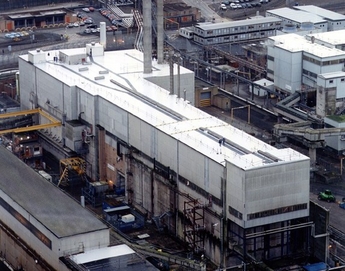A trial of a liquid activity reduction process has transferred about 15,000L of active liquor from a waste silo to the site ion exchange effluent plant (SIXEP) at the UK's Sellafield site. Now that the process has been proven to work, it will be used to remove about 90% of the silo's radioactivity over the next few years.

The original Magnox Swarf Storage Silo was constructed in the 1960s with three further extensions built in the 1970s and 1980s. Intermediate level waste, mainly comprising Magnox fuel cladding, was stored under water in the 22 individual compartments within the facility. The Magnox Swarf Storage Silo stopped receiving bulk waste in 1991 and alternative modern storage facilities were provided in the form of encapsulation plants.
Hugh Bourque, Head of Programme Delivery said: “The active liquor has had to be pumped from the compartments and transferred across the Sellafield site in a high level shielded pipebridge. The liquor is then treated in our SIXEP facility which filters contaminated water using a special sand called clinoptilolite to remove radioactivity from the effluent." Clinoptilolite is a naturally occurring alumino-silicate which was sourced from the Mojave desert in California.
The SIXEP process captures more than 99% of the main radioactive feed in a solid form and discharges cleaned water to the sea.
The LAR transfers will take place in 7.5m3 lots, containing approximately 75 TBq. Some 15m3 containing approximately 150 TBq will processed each week. After each transfer, the silos will be topped up with clean water before the operation is repeated on a weekly cycle. This will gradually reduce the silo liquor activity through dilution, significantly reducing the overall environmental risk from the facility and radiation dose to the plant workers.
Bourque said: “The significance of this achievement cannot be underestimated. This is a high hazard project with which we have had to work very closely with the regulators in order to prove that we have the capability to safely commence the process.
“The LAR programme is an excellent example of flexible permissioning which has been developed with our regulators to accelerate risk reduction through an expedited licensing process. This has meant that the period between handover of information and regulatory permission was reduced to 3 weeks as opposed to the standard 18 weeks.”
Related Articles14 new reactors by 2030 Japanese consortium buys in to Uranium One




